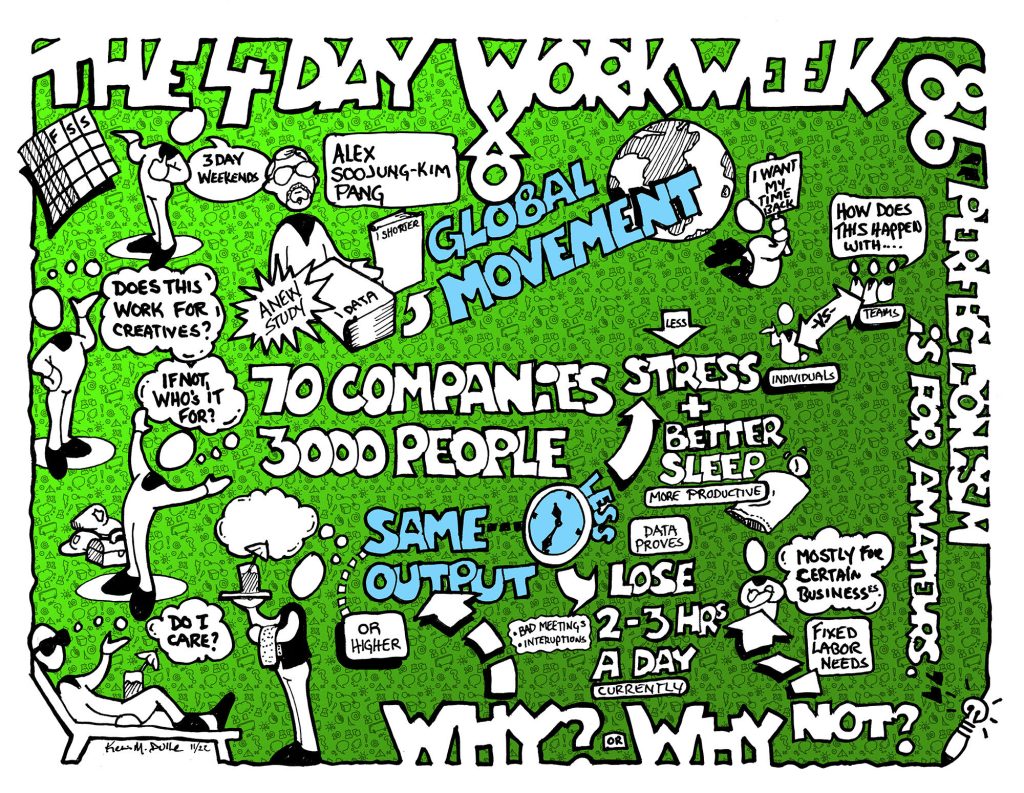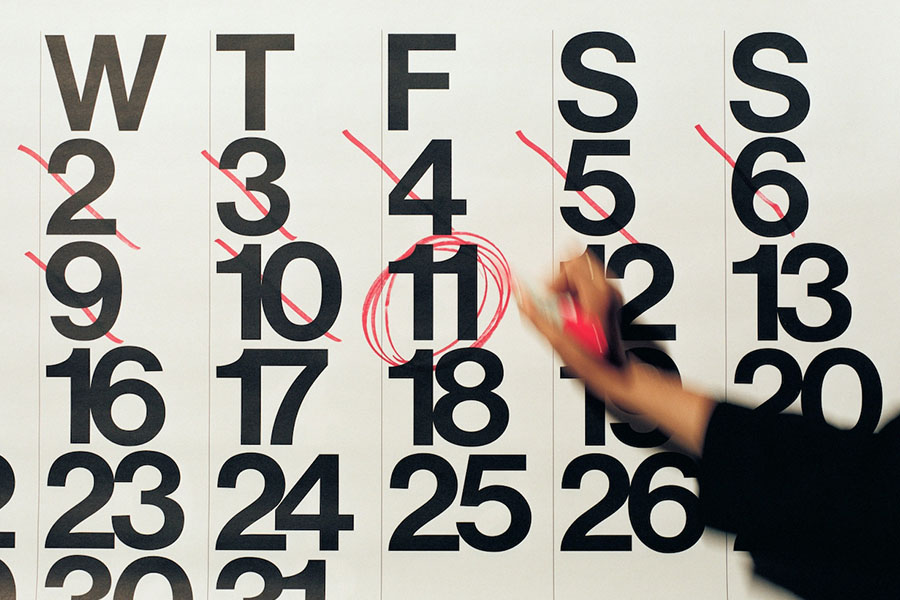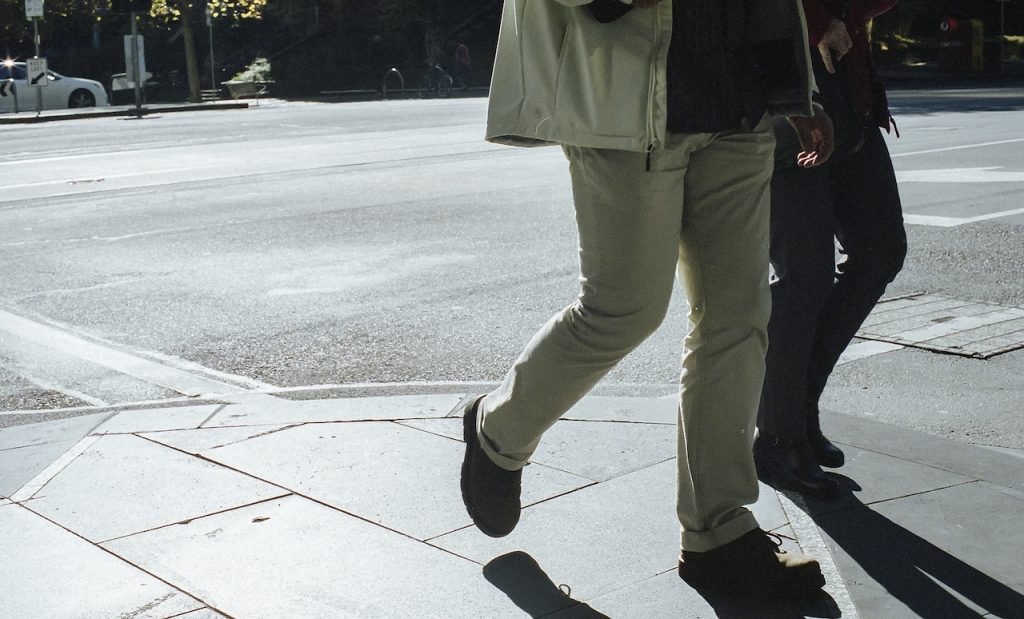If fewer hours at work = more productivity and creativity… what does that mean for experiences?
The 4-day workweek is a movement that’s gathering momentum all over the world – not just in Europe and the US, but also in countries like Japan and Korea that actually have words for “working yourself to death”.
And as a growing number of companies cut back their working days to address issues such as poor mental health and low productivity, the early results appear to be revolutionary. Employees report a greater sense of wellbeing, better work-life balance, and ability to keep on top of their work, while employers can enjoy increased productivity and retention rates.
So, what does this mean for experience designers? Well, a 4-day workweek means – you guessed it! – 3-day weekends.

In his 2019 book Spending Time, Daniel S. Hamermesh explains that while our life spans have got a bit longer – 13% since 1960 – our spending power has surged by 198%.
“It makes it difficult to stuff all the things that we want and can now afford into the growing, but increasingly relatively much more limited, time that we have available to purchase and to enjoy them over our lifetimes,” he writes.
If the 4-day workweek takes off, presumably we’ll have more time into which we can “stuff all the things we want”. More time to fill with experiences that make us more creative, curious and happy.
Palo Alto-based futurist and author Alex Soojungkim-Pang is one of the leading champions of the movement. (For a headstart on the topics in this Campfire, catch up on his previous talk on the importance of creative rest in The Transformative Power Of Time Well Designed.)
His most recent book, Shorter: How Working Less Will Revolutionise The Way Your Company Gets Things Done, takes global research into companies already trialling the 4-day workweek without reducing salaries or expectations, and outlines the learnings and strategies we might apply in our own professional and personal lives.
We also think there’s a lot that experience designers can take from his work and apply to their own experiences. How do we play with people’s perception of time? Are boundaries a necessity or an evil? And how can we help people to feel more productive and fulfilled with the same amount of hours? You might find some of these answers below. With others, only time will tell…
The 4-Day Workweek Is For Everyone, Not Just Creatives
One of the most-cited criticisms of the 4-day workweek is that it’s only really for a small subset of the workforce – generally Western knowledge workers or creative companies who are more willing and able to experiment with how they apportion time. While this might yield some benefits for these individual firms, it’s unlikely to trigger a revolution in working practices.
“We all need to go there if this is to have an impact.”
Klaus Paulsen
However, Soojungkim-Pang’s early research suggests that the geographical, national and industry differences are lesser than we might expect. The 4-day workweek is a genuinely global movement, with companies adopting the trend in Latin America, India, Malaysia, Taiwan, Singapore, Korea and Japan. These different geographies may have different initial concerns – for example, it’s no surprise that Brits are obsessed with Bank Holidays – but cultural differences don’t appear to be an insurmountable barrier.
And while highly seasonal workers or those who commute to their jobs via helicopter, such as oil rig workers, may struggle to follow the 4-day workweek, outside of these outliers the 4-day workweek also crosses a wide variety of industry lines.
Hutch is a mobile gaming company located in London. Pursuit Marketing is a b2b sales and marketing agency in Scotland. Pressure Drop Brewery makes beer in the warehouses of Tottenham in East London. All have been inspired to try 4-day workweeks.

“There are plenty of companies in industries with fixed labour needs such as manufacturing or nursing that have moved staff to shorter workweeks as effectively as creative firms. Systemic benefits such as lower turnover and greater loyalty offset the increased costs of having more workers on the payroll.
And while we might not think of a nurse’s assistant as a “creative job”, it requires a lot of empathy, problem solving and other creative skills, and therefore would benefit from a 4-day workweek every bit as much.”
Alex Soojungkim-Pang
The reasons for making the leap generally fall under one of three categories:
- To try and solve everyday existential issues such as recruitment, retention, work-life balance, or corporate wellness initiatives. The ongoing reinvention of work and popularisation of hybrid working in the wake of the pandemic have undoubtedly turbocharged this process.
- A founder or CEO health scare, burnout or loss that makes them realise they need to change the way they work, bringing their company along on the journey with them.
- A small, motivated team of people who are willing to work together to take up the challenge and implement the necessary changes to make it work.
How To Take The First Steps Towards A 4-Day Workweek

You might be sold on the idea of a 4-day workweek in theory, but struggling to figure out how to make the transition. However, while it might seem like a dramatic change, Soojungkim-Pang points out that in many ways the 4-day workweek is already here – it’s just buried beneath an excess of bad habits, such as:
- Poorly run meetings
- Distractions and interruptions, from the constant battle for Inbox Zero to that colleague who always has “one quick question”
- Badly used technology
These habits add up to 2-3 hours of lost time per day. So what can we do to stop these time leaks?
The good news is that it’s not about implementing lots of fancy new tech or turning to AI. Instead, the big innovations are practices: there’s a bunch of everyday changes you can make to ensure you’re being just as (or more) productive on fewer hours.
- Shorter, more pointed and disciplined internal meetings.
- Using existing tools more thoughtfully and in more sophisticated ways, as well as adding new tools such as Slack bots or email/meeting templates.
- Redesigning the workday to make space for “deep work” or meeting-free days. The evidence suggests this can deliver outsize benefits – in an MIT Sloan article, researchers found that companies that can eliminate meetings on 2 days of the week are roughly 70% more productive. Although we might argue with the specifics of this stat, the trend is certainly in a positive direction.
- Creating guidelines for engagement with work on days off, finding deliberate and discreet ways of managing both your inbox and your anxiety.
- Reinventing the way you use physical office space. Else, a design firm based in London, now has two sets of meeting spaces in its open-plan office: a cosy, sofa set-up for external meetings, and an uncomfortable, small set of tables and chairs for internal meetings. They also have egg timers on each desk and a novel “On Air” sign linked to employee calendars that indicates when someone is on a client call.
Other Experiments In Time Manipulation

The 4-day workweek is the most popular and easiest for people to instantly appreciate the radical benefits, but it’s not necessarily the only change you can make if you want to experiment with different working hours.
Some companies are experimenting with “trimming” the average day to 6 hours, which might deliver some benefits – parents might prefer being able to pick up the kids from school. However, this doesn’t make you rethink how everything works or encourage companies to think outside the box in the same way as the 4-day workweek.
Some WXO Members are already experimenting with different working models. Stefan Weil only allows employees to be booked for 90% of their time, so they have 10% to themselves. Pigalle Tavakkoli mentioned that Ableton pays for their staff to have 2 weeks to concentrate on their music/art/side hustle, which they can present back to their teams if they wish. And Claudia Ursulet-Popa put forward that in Romania there has already been a legal initiative for the 4-day workweek, allowing employees to decide if they want to work 4 or 5 days as long as they continue to work 40 hours per week.
The model may vary depending on the industry, market and how people can work effectively, and while Soojungkim-Pang still believes the 4-day workweek is the best idea we currently have, this is still an area ripe for experimentation.
“We’re in a period when a thousand flowers are blooming in terms of work-time experiments. The 4-day workweek companies are the elite athletes, but there are still lots of things you can learn from them even if you’re not ready to follow them.”
Alex Soojungkim-Pang
The Outsize Benefits Of The 4-Day Workweek

Why go through all this disruption and hassle? Because, quite simply, the results speak for themselves.
The UK project of over 70 organisations and 3,000 people that Soojungkim-Pang tracked in his book saw the following results:
- 55% saw the same output from working 4 days as working 5, and 40% actually saw a higher output.
- Workers reported a better work-life balance, lower levels of stress and burnout, and sleeping 1 hour longer and better than before.
- 95% said they were likely to continue working in this way.
Three other examples of companies that saw beneficial results from trialling the 4-day workweek are:
- Korean start-up Woowa Brothers, who started ratcheting down working hours in 2015. Four years later they had increased more than tenfold, showing that having ambitious revenue and growth targets isn’t incompatible with implementing a 4-day workweek. In fact, it forced them to be more thoughtful and more competitive when hiring talent.
- XXX in Denmark also started with a 4-day workweek in 2015. They used a ratings platform called Officevibe to take the temperature of their employees. After an initial big jump in satisfaction followed by some fluctuation as people adapted, they have since seen a steady rise in communication, collaboration and trust.
- Synergy Vision, a medical editing company in London, surveyed their staff just before and then 6 months into the 4-day workweek. The percentage of people who reported to be very happy rose from 12% to over 50%, also saying that they had more time for hobbies, better work-life balance etc. 79% also said they could keep up with their workload compared to 50% before, even though their hours were going down.
And while the data is still being gathered, estimates suggest that there may be some climate benefits to the 4-day workweek. Studies show that if the UK were to move entirely to this system, for example, it would amount to energy and carbon savings equivalent to taking every car in Britain off the roads.
The concept of the 4-day workweek may not yet be mainstream – but it’s much further along the road to acceptance than before the pandemic.
“It’s gone from a crazy, radical idea to something in the early stages of the adoption curve. It proves that it is possible to redesign our work in ways that improve the experience on a day-to-day basis, but also find a measured and more sustainable place for work in our lives.”
Alex Soojungkim-Pang
Redesign The Perception Of Time, Not Time Itself

The example of Synergy Vision’s staff feeling more able to keep up with their workload in the same number of hours – plus the general trend in the data that shows people are equally or more productive in 4 days as they are in 5 – is an exciting demonstration of how our psychological sense of time is flexible.
When people have more control over their time, more autonomy, and the ability to choose tasks, they feel like they have more time overall. Time may move forward at a rate of one second per second, as Joe Pine mentioned in our last Campfire, but the way we experience it is very different.
This is why Pine is working on a new measure of Time Well Spent (TWS) to replace Net Promoter Score (NPS). It also reminds us of Rory Sutherland’s point in Campfires 48 & 49: Who Wants To Be An Experience Alchemist? that often it can be more effective, not to mention cost effective, to try and change people’s perception of a thing, rather than the thing itself.
We think this presents an amazing opportunity for experience designers, who after all, design both people’s time and perceptions. How might we play with perspective to make people feel that they have experienced Time Well Spent? Perhaps it’s not about helping them not to manage their time, but their energy.
“It’s about the perception of whether I’m enjoying my time. Sometimes people get burned out in their personal lives too, so might want to escape to work. And if I’m burned out at work, I might want to escape to my family. We could also redefine our perception of work, moving it from something we have to do, to something where we’re developing our own life skills that can also be applicable outside of the workplace. ”
Mike Gunawan
(For more tips on redesigning our perception of time, check out Why Experience Design Is Also Time Design – Plus 5 Books To Help You Master It.)
And of course, one of the basic requirements for flow is a sense of timelessness, or our perception of time vanishing. As Pine explains in his Multiverse model, we don’t only operate in the dimension of Time, but also of No-Time. How might we help people access this flow dimension? (Some answers might be found in Campfire 30: How To Design For Flow.)
Does Customisation Threaten Community?

In our previous Campfire, Pine discussed how mass customisation is the future of the transformation economy. However, when applied to the 4-day workweek, this could cause some conflict.
“For decades, we’ve been saying that people will have more time to go and experience things. The pandemic and working from home have affected our way of consuming experiences, so it’s more difficult to have a global, general approach. It’s the refinement of customisation to its outmost manifestation.”
Lou Murray
A recently joined WXO Member was raving about the problem with personalisation, as it’s the opposite of belonging. If people pick and choose too much, it might not be good for our sense of community. After all, the fun of a weekend is that it’s shared time away from work.
So when implementing a 4-day workweek, perhaps companies should be firm about it facilitating a 3-day weekend, rather than being taken at the employee’s discretion. And for experience designers, we should consider the cost of customisation and how we can balance it out with experiences that encourage community and connection.
Your Time Is Yours To Design

Perhaps one of the biggest strengths of the 4-day workweek is that it encourages us to think about how we currently divide our time, where those boundaries are necessary, and where they might be arbitrary and thus subject to change.
The Greeks had two concepts of time: chronos, or quantitative time, but also kairos, or qualitative time. Meanwhile, the two-day weekend is a modern invention of Henry Ford’s, who wanted to give people a reason to buy one of his cars by giving them somewhere to go at the weekend.
Whatever you think of these concepts of time, they show that we probably have more wriggle room to set our own boundaries than we think. As long as we’re making room for both deep work and deep play (see Campfire 73: The Transformative Power Of Time Well Designed for more of a deep dive into the importance of both), we can find our own balance.
“Knowledge work is a black hole. The challenge is to be as efficient and ruthless as possible with those things that just take time, so we have more time for the black hole of creativity.”
James Wallman
The WXO Take-Out
Soojungkim-Pang thinks there are three main takeaways experience designers can take from the 4-day workweek.
- It’s not just what you do, it’s what all of you do. 95% of the gains of the 4-day workweek are changes in communal habits and social norms. We’ve had a generation of efforts to improve work-life balance that are focused on what individuals can do, and these have gone as far as they can go. But there are far fewer limits on what we can all do together to solve the problems of burnout and time management.
- Boundaries are really good things. The idea of “blurring the work-life boundary” assumes that’s positive, but it’s not. Better boundaries within the day enhances both work and play (as Nir Eyal puts forward with his “time-boxing” concept in Campfire 51: Indistractable!), giving you better opportunities for rest and recuperation, as well as being more focused at work.
- Lots of devoted people have serious hobbies that give them the satisfactions and rewards of work when it goes well, minus the frustrations and in a compressed timescale. It’s not enough to think you’ll do nothing on your rest days – it’s more restorative to have deep play that is just as engaging as work.
So next time you’re designing an experience, ask yourself:
- As more people swap the 5/2 for the 4/3 week, what might this mean for the experiences you design?
- How might you redesign your experience in order to help people be more creative and productive?
To continue the conversation, WXO Members can head to the topic on My WXO here.
To see the full line-up for the WXO Campfires Season 5, click here.
To apply to join the WXO and attend future Campfires, click here.





